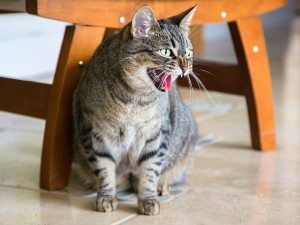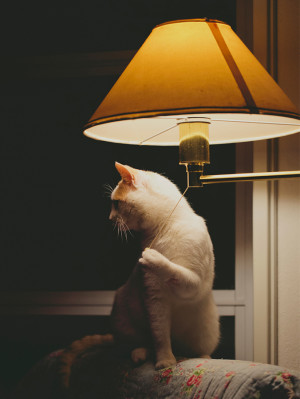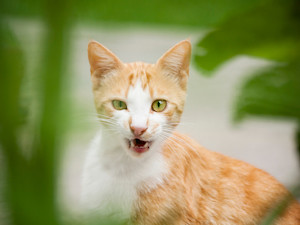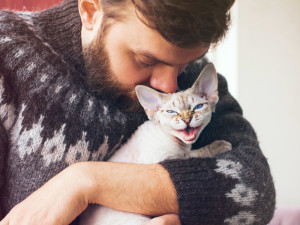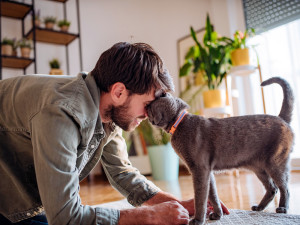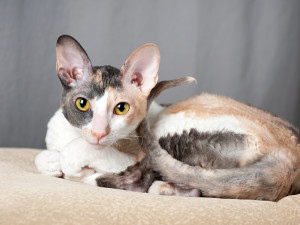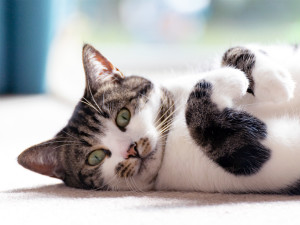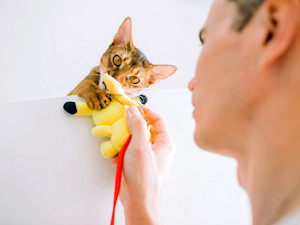Cat Chat: Why Do Cats Meow At Humans... But Not Each Other?
Meowing isn’t something adult cats naturally direct at each other – they’ve adapted it just for us
If you’re a cat parent, you’ll no doubt be familiar with your cat’s meow. When a cat wants to get your attention – perhaps to go outside or because they’re hungry – they will often meow at one of their humans.
Unlike other feline vocalisations, such as hissing, however, meowing is almost always directed at humans. Cats – at least, adult cats – seldom meow at each other. So, why do they meow at us?
Why do cats meow at humans?
Meowing is something kittens do to communicate with their mothers for milk and attention. It’s sometimes thought that pet cats live in a state of extended kittenhood, as we humans function as sort of surrogate mothers for them. It’s a form of neoteny; adult animals keeping features or behaviours they had while younger. This can explain why adult cats meow at humans, as well as why they partake in soothing behaviours such as kneading.
Cats have developed their meow for humans over time, modelling it on a child’s cry – the idea being that people are more likely to respond to them just as they might a crying child. By the same token, the way people speak to their cats has a lot in common with the way people speak to children, as opposed to the way adults speak to each other.
Both meowing from a cat and crying from a human baby are learned behaviours that use a form of vocalisation to get the desired response – be it food, access to outside, a changed nappy or just attention and affection.
Do cats view humans as parents?
You might have heard that our cats view us as big, clumsy cats, or as friends or roommates. Whilst elements of this are certainly true, Dr Anna Foreman, in-house vet at Everypaw Pet Insuranceopens in new tab, explains that cats primarily view us as parents or caregivers – specifically mothers. “We are their source of food, attention and comfort as their mothers would be,” she explains.
A study published in Animal Cognitionopens in new tab in 2022 shows that cats adapt their vocalisations for human interactions, while cats can distinguish between speech addressed to them and speech addressed to adult humans when it comes from their parents, indicating that there is almost a parent-child relationship between cat and human.
And it’s not just meowing that cats can use. One study from 2009opens in new tab involved participants listening to purrs from cats seeking food (solicitation purrs),and cats not seeking food (non-solicitation purrs). Both cat parents and non-cat parents rated the solicitation purrs as less pleasant and more urgent, again mimicking the cry of a human infant when they want something.
How do cats communicate with each other?
Adult cats rarely meow at each other. Rather they communicate largely through body language, as well as through other noises, such as hissing, spitting and yowling.
Because humans can’t read cat body language and non-verbal cues as well as other cats can, additional vocalisations like meowing are needed as an additional form of communication. When kittens meow at their mother, they learn that the noise gives them what they want. And because we function in a similar way, adult cats transfer this behaviour onto humans – they don’t need to meow at other cats.
Cats are clever when it comes to adapting their behaviour and methods of communication to interact with humans. While they’re sometimes stereotyped as being aloof or uncaring, this isn’t the truth. They strive to better understand the humans in their lives and adjust their behaviour to allow us to meet their needs. Studies have even shownopens in new tab that cats can recognise and respond to emotional expression from humans, too.
Why do some cats meow more than others?
While each cat is unique, some breeds – such as Siamese cats – generally meow more than others. Meanwhile, some cats may become more vocal as they get older, if they have cognitive dysfunction, or if they develop the condition hyperthyroidism (overactive thyroid).
Dr Foreman adds, “If they are feral, in which case they vocalise as if we were another cat.” Cats who’ve spent a lot of time on the street may not develop a need to meow.
Understanding different types of cat meows
�“Each cat is an individual and so their human caregiver will learn what their meows are trying to communicate over time,” says Dr Foreman. “Accompanying body language and directional indications (hitting a bowl for food for example) also help us to work out what they want!”
Meows can differ depending on what the cat wants – take note of pitch, tone, volume and length. A meow for food might be different to a meow that’s simply to say hello. The persistence of a cat’s meow will usually indicate how urgently they need something, too.
You might hear younger cats make shorter ‘mews’ when they’re hungry or lonely, and want a good fuss. Meanwhile, a longer ‘meowww’ could mean that your feline is worried, annoyed or otherwise unhappy – there’s something going on that they aren’t enjoying.
A short, high-pitched meow from an adult cat will often mean ‘hello’, while longer, high-pitched meows can mean that your cat is hurt or startled. A low-pitched meow can indicate unhappiness, if perhaps you’ve done something your cat doesn’t like. A regular meow, however, tends to be mid-length and mid-pitched, and usually means that your cat wants something – it’s the type of meow you’re probably most familiar with.
Constant meowing, however, could mean that your cat is injured or ill. So, if your cat is meowing incessantly, it may be time for a trip to the vet to rule out any more serious underlying causes.
Frequently asked questions
When should I be concerned about meowing?
It’s important to remember, above all, that every cat is different. The more time you spend with your cat, the easier you’ll find it to pick up on what their meows mean. But, if you’re in any doubt or have any concerns, it’s always worth consulting with your vet to make sure your cat is given the all-clear.
Should you talk back to your cat when they meow?
Yes, responding to your cat’s meows can help strengthen the bondopens in new tab between you and your pet. Engaging with your cat by talking back can encourage positive communication, making your cat feel heard and understood.
Can cats understand human speech?
While cats don’t understand words as we do, they can distinguish between speech directed at themopens in new tab versus normal adult conversation. This ability to differentiate suggests that cats are more attuned to human vocal patterns than we might expect.


